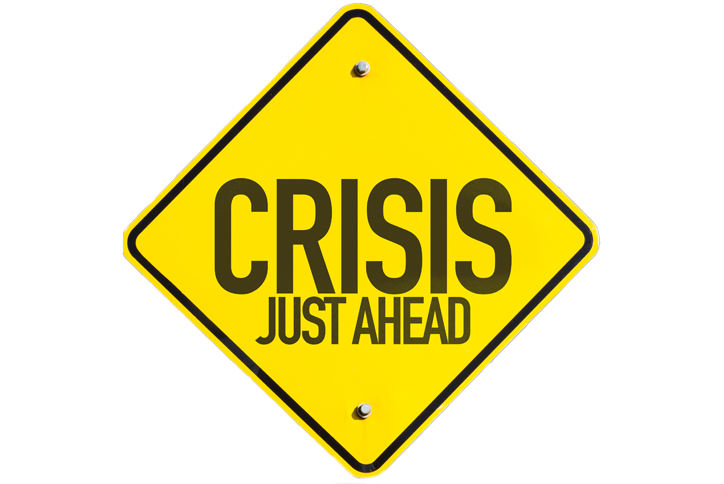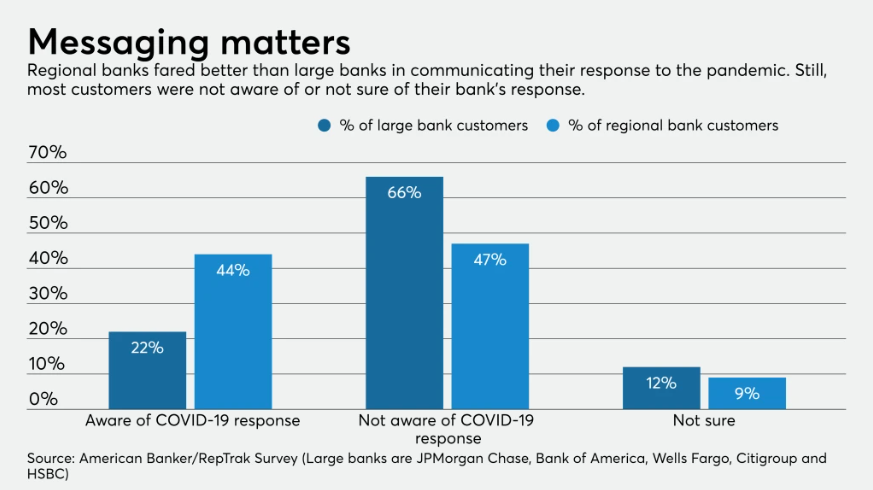
It doesn’t take much to squander good will, does it? It wasn’t long ago, remember(?) when the banking industry’s reputation was riding high, buoyed unfortunately, by a global pandemic. That rise in the industry’s rep was well documented in an American Banker article dated August 2020, “How regional banks edged out larger rivals in reputation rankings,” along with the importance of timely, relevant marketing messaging, as summed up in the chart below:

Back then, we talked – in our blog, Banker Action Figures? You Never Know…” – about how bankers should perhaps be immortalized as action figures, so admired were they for the good work they were doing for customers who were struggling financially and looking for someone (or something, in the case of their local bank) to turn to.
The recent RepTrak survey – just made public a few days ago – tells a much different story. According to American Banker’s, “Banking crisis drags down reputations across the industry,” “the public perception of banks took a hit this year after a string of bank failures forced many customers to take a hard look at their financial service providers. The industry saw its biggest decline in sentiment since 2018, according to American Banker's annual reputation survey, with regional banks accounting for the bulk of this deterioration”. The findings are a powerful reminder that a bank’s reputation is highly vulnerable.
What happened? We know that the failure of Silicon Valley Bank, Signature Bank, and First Republic didn’t help banks, no matter their size, in terms of brand image. Back in May, we talked about how those failures could, in fact, have a silver lining for smaller banks. Rebecca Romero Rainey, CEO of the Independent Community Bankers of America, said at the time, “the failure of these institutions presents an opportunity for community bankers, who are ready, willing and able to answer questions about the latest developments at larger financial institutions.”
Well, in this ever-evolving, financial industry landscape, just about anything can happen. And in this case, that “anything” was a host of bank failures. That’s why trust and reliability are paramount… all the time. Bank marketers must recognize the profound importance of building and maintaining a positive brand image. This is, of course, especially critical during times when customers rely on you the most; such as uncertain economic times, bank failures, or global pandemics. But, you can’t wait until that happens.
It’s pretty much a known fact that it’s five to seven times more costly to acquire a customer than it is to keep one. A significant factor in the difference in cost is that consumers tend to buy from brands they trust. This is why it takes a lot more effort to convert a new customer than to keep a loyal one. A robust brand image not only safeguards a bank's reputation, but also plays a pivotal role in shaping customer loyalty, attracting new business, and ensuring the institution's long-term success. According to Forbes, “statistics show an increase in customer retention by 5% can lead to a company’s profits growing by 25% to around 95% over a period of time.”
So, yes, you want to keep your existing customers. But, there’s no reason why you can’t do both; keep existing customers and attract new ones. A sterling brand image extends beyond retaining existing customers; it also acts as a magnet for new ones. During those moments we talked about above, people are often prompted to explore alternative financial institutions that they believe are more reliable, trustworthy and customer-centric. Those banks that have built and maintained a strong brand image will stand out during those moments. And that’s what you want your bank to do… stand out.
Use your social platforms
Social platforms are ideal for this type of “brand maintenance.” What are some of the topics you might want to address in your messaging in order to maintain that “robust” brand? Use the “80/20 rule” when posting: Since social media seldom drives the purchase of banking related services, 80% of posts should be fun, entertaining or useful to your audience, and only 20% of content should be related to a financial product or service of some kind. Here are just a few suggestions:
- Money management “tips and tricks”
- Customer testimonials
- Community events you attend and/or support
- Staff stories: anniversaries, promotions, etc.
- Funny, inspirational quotes/memes
- Product/service info/updates/promotion
- Success stories
So, in short, don’t wait for a crisis.
Trust, reliability, and a commitment to both personal relationships and ethical practices are the bedrock of a bank's brand image. These qualities are, of course, invaluable during economic crises, global pandemics, or personal financial emergencies. But don’t wait for a crisis to make your brand top of mind. This is an on-going process, and with the use of social media platforms, a relatively inexpensive and easy-to-implement one, as well.
About Bank Marketing Center
Here at bankmarketingcenter.com, our goal is to help you with that topical, compelling communication with customers; the messaging — developed by banking industry marketing professionals, well trained in the thinking behind effective marketing communication — that will help you build trust, relationships, and revenue.
To view our marketing creative, both print and digital – ranging from product and brand ads to social media and in branch signage – visit bankmarketingcenter.com. You can also contact me directly by phone at 678-528-6688 or via email at nreynolds@bankmarketingcenter.com. As always, I welcome your thoughts.